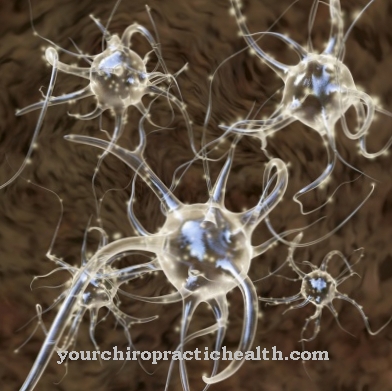Under the Abdominal skin reflex the neurologist understands a foreign reflex that causes the abdominal wall muscles to contract when the skin is rubbed. The polysynaptic reflex is interconnected via the spinal cord and its absence can indicate pyramidal damage. Multiple sclerosis is a possible cause of such a lesion.
What is the abdominal skin reflex?

Man is endowed with different reflexes. They are all triggered by certain stimuli. Which organ of perception is associated with a reflex depends on the type of reflex. Reflexes are divided into two main groups: self-reflexes and external reflexes. In contrast to the self-reflexes, the affectors and effectors in the external reflexes are not in the same organ.
The descending and ascending nerve fibers are referred to as effectors and affectors. Affectors transport action potentials towards a certain stimulus, i.e. towards the central nervous system, while effectors carry stimuli away from the central nervous system.
The abdominal skin reflex is one of around ten external reflexes in humans. The reflex movement is triggered by brushing the abdominal wall and is an important part of the neurological examination. The point of irritation of the abdominal skin reflex is the skin. Its target organ are the abdominal wall muscles.
Neurology differentiates the abdominal skin reflex into an upper, middle and lower reflex. The neurological reflex examination checks the abdominal skin reflex on all three levels.
Function & task
Like all motor reflexes, the abdominal skin reflex in the spine is connected to the pyramidal system. This interconnection guarantees a particularly rapid reflex response, which is crucial for the function of all reflexes.
The thoracic nerve tracts Th8 to Th12, which are interconnected in the pyramidal system of the spinal cord, are involved in the reflex movement of the abdominal skin reflex. As a foreign reflex, the abdominal skin reflex is a polysynaptic reflex, the reflex arc of which takes place over several synapses. The sensitive skin nerves are involved in the reflex as triggering nerves.
The motor nerve pathways of the abdominal wall muscles are the organ of success and initiate the contraction movement of the muscles. The smooth muscles of the abdominal wall consist of the rectus abdominis, the transversus abdominis and the obliquus externus abdominis muscles. These three muscles belong to the skeletal muscles and are innervated by motor nerves, which in the case of the abdominal skin reflex receive a potential from the spinal cord and then contract.
During the neurological reflex examination, the patient lies on his back. The doctor quickly strokes with a needle from the lateral skin of the abdomen towards the center. This stroking movement takes place from both sides and is carried out at three different heights of the abdominal skin. As a rule, the reflex is checked both at the level of the costal arch, at the level of the navel and above the groin. When the reflex is maintained, the abdominal wall muscles contract on all three levels.
Like all other reflexes, the abdominal skin reflex is completely involuntary and primarily has protective functions. The contraction of the abdominal wall muscles hardens the abdominal wall and protects the internal organs.
Like all external reflexes, the abdominal skin reflex is one of the exhaustive reflexes. The reflex movement cannot be triggered as often as desired. Age is also related to the reflex. In terms of age physiology, the abdominal skin reflex can therefore no longer be triggered in some elderly patients. As part of the reflex examination, the doctor must observe these parameters in order to correctly interpret a lack of abdominal skin reflex.
Illnesses & ailments
On a slack abdominal wall, the abdominal skin reflex is difficult or impossible to trigger. The same is true on an obese abdominal wall.
If the abdominal skin reflexes can no longer be triggered on a physiologically normal abdominal wall, this is interpreted as a so-called pyramidal path sign. The pyramidal trajectory signs indicate damage to the pyramidal tract that connects the first and second motor neurons in the spinal cord. Other pyramidal orbit signs are the reflexes of the so-called Babinski group. These are pathological reflex movements that cannot be triggered in healthy people and that indicate damage to the motor neurons themselves.
The abdominal skin reflex is often absent on one or both sides in patients with multiple sclerosis (MS). In this disease, immunologically induced inflammations demyelinate the central nervous system and thus deprive the nerves of their conductivity. In the case of an acute MS attack, sensory disorders of the abdominal skin can also be the cause of the lack of reflex. Because if the receptors of the abdominal skin do not register any excitation, they cannot pass the triggering information on to the central nervous system and the motor reflex response is accordingly absent.
An extinguished abdominal skin reflex is therefore not necessarily associated with a pyramidal lesion, but can also be due to a peripheral lesion, as can occur, for example, in the context of a polyneuropathy. Polyneuropathies can be caused by malnutrition, nerve damage in the peripheral nervous system, or infections and poisoning.
If damage to the spinal cord is causally related to a lack of abdominal skin reflex, these lesions may also have been caused by a spinal infarction or a degenerative disease of the central nervous system, such as ALS, and are often associated with spastic paralysis.
In most cases, an increased abdominal skin reflex has no disease value and can, for example, be physiologically related to a generally lively reflex response.

























.jpg)

.jpg)
